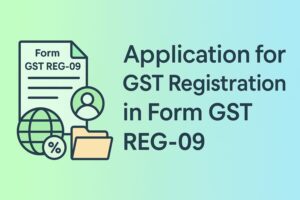A Guide on GST Registration on Export of Services in India
- 8 Aug 24
- 10 mins

A Guide on GST Registration on Export of Services in India
Key Takeaways
- Compliance and Optimization: Understanding and adhering to the GST framework for exporting services is crucial for compliance and optimizing tax liabilities.
- Zero-Rated Supplies: The export of services under GST benefits from being zero-rated, allowing for competitiveness and tax refunds.
- Mandatory Registration: Registration under GST is mandatory for service exporters, irrespective of turnover.
- Documentation and Refunds: Proper documentation is essential for exporting services and claiming refunds, enhancing the business's cash flow and competitiveness.
The export of services under India's Goods and Services Tax (GST) system is a critical issue for businesses that supply services outside of India's borders. Knowing the framework and benefits of exporting services under GST is critical for businesses to ensure compliance and minimize tax liability.
Here’s a comprehensive overview of GST registration for the export of services in India.
Export of Services
Under the GST regime, a service is considered an export if it meets the following criteria:
- Supplier of Service: Must be located in India.
- Recipient of Service: Must be located outside India.
- Place of Supply: Should be outside India.
- Payment: Received in convertible foreign currency or Indian rupees, as the Reserve Bank of India may permit.
- Supplier and Recipient: Not merely establishments of a distinct person, ensuring that the supplier and recipient are distinct entities.

Export of services is considered a "zero-rated supply" under GST. This means that the services exported are not subject to GST. Exporters have two options for tax relief under this provision
GST Rate for Export of Services
- Export Without Payment of Tax: Exporters can export services without payment of GST by furnishing a Letter of Undertaking (LUT), allowing them to trade services without the payment of IGST.
- Export With Payment of Tax (Refund Claim): Exporters can choose to pay IGST on the services exported and then claim a refund of the tax paid. This option might be beneficial for exporters who have a significant amount of input tax credit (ITC).
Documentation and Compliance
For GST registration on the export of services under GST in India, businesses must comply with specific documentation requirements, including:
- Invoice: Issuing a tax invoice as per GST regulations, detailing the description, value of services, tax charged (if any), and other mandatory details.
- Letter of Undertaking (LUT): Exporters opting to export without payment of IGST must furnish an LUT in Form GST RFD-11 on the GST portal.
- Shipping Bill/Bill of Export: While primarily applicable to goods, certain services paired with goods might require these documents for customs clearance.
Key Points on GST registration for export of services in India
- Mandatory Registration Irrespective of Turnover: Exporters of services are required to register under GST regardless of their annual aggregate turnover. This means that even if the turnover is less than the threshold limit (INR 20 lakhs or INR 10 lakhs for special category states), the service exporter must obtain GST registration.
- Zero-Rated Supply: Under GST, exports of services are treated as “zero-rated supplies.” This means the exporter can supply services without GST but is eligible to claim the input tax credit (ITC) for the tax paid on inputs used to provide such exported services.
- Options under Zero-Rated Supply: Exporters have two options for exporting services:
- Supply services under a bond or Letter of Undertaking (LUT) without payment of IGST and claim a refund of the unutilized ITC. Pay IGST on exported services and claim a refund of it.
- Compulsory Compliance: Once registered under GST, exporters must comply with all the procedural requirements, such as filing of returns, maintaining detailed records of trades, and adhering to the compliance under the GST laws.
- Benefits of Registration: Registration under GST not only ensures compliance but also provides benefits such as the eligibility to claim refunds on taxes paid on inputs used to provide exported services, enhancing the competitiveness of Indian services in the global market.
- Special Provisions for Certain Services: There are specific provisions for certain types of services where the place of supply is considered outside India, even if some conditions are met. The service provider needs to keep these provisions in mind because they may have GST implications.
Documents Required for Claiming Refund
For claiming a refund on exports, the documentation plays an important role in validating the trade transactions and facilitating the refund process. The key documents required include:
- GST Invoice: A tax invoice indicating the GSTIN of the supplier, the tax charged (if any), and a statement that the GST is payable on a reverse charge basis (if applicable).
- Shipping Bill/Bill of Export: In the case of goods, the shipping bill filed with customs acts as a primary document evidencing the export of services or goods.
- Bank Realization Certificate or Foreign Inward Remittance Certificate: Proof of receipt of payment in convertible foreign exchange is crucial for services exported.
- LUT/Bond: Where applicable, a copy of the LUT or bond filed by the exporter.
- GSTR-1 and GSTR-3B Returns: The details of the exports and the tax paid (if any) need to be reported in the monthly/quarterly GST returns filed by the exporter.
- Application for Refund: Form GST RFD-01 needs to be filed on the GST portal along with all necessary documents to claim the refund.
GST on Exports: How Will It Be Levied?

By preventing domestic taxes from impacting Indian goods and services, GST (Goods and Services Tax) on exports from India aims to increase trade's competitiveness in the global market. Here's how GST is levied on exports:
- Zero-Rated Supply
Exports under GST are treated as "zero-rated supplies." Zero-rated means that the goods or services exported are taxed at a rate of 0%. This provision ensures that exporters can compete on a level playing field in international markets, as their prices do not include taxes that would make their offerings more expensive.
- Mechanisms for Zero Rating
There are two mechanisms available for exporters under the GST regime to facilitate zero-rated supplies:
- Export Without Payment of GST
Exporters can supply goods or services without paying GST by submitting a Letter of Undertaking (LUT) or a bond. This mechanism ensures that the capital of exporters is not tied up in tax payments, thereby aiding in better cash flow management.
The LUT/bond is a guarantee that the conditions for trade will be fulfilled, and it allows the exporter to claim refunds on the Input Tax Credit (ITC) for taxes paid on inputs used to manufacture the exported goods or services.
Export With Payment of GST
Alternatively, exporters have the option to pay GST at the time of trade and then claim a refund for it. This option is beneficial for exporters who have accumulated a large amount of ITC and wish to utilize it against the GST payable on exports.
Deemed Exports
In addition to regular exports, the GST law also covers "deemed exports," which refer to certain specified supplies of goods that are not actually taken out of India but are considered trade for the purpose of GST benefits. Deemed exports are also eligible for a refund of tax on the supply of goods, similar to regular exports.
The criteria and list of deemed exports are specified by the GST Council and include supplies to export-oriented units (EOUs) and supplies against advance authorization, among others.
Conclusion
The Goods and Services Tax (GST) regime in India significantly benefits businesses exporting services, making them more competitive globally by removing domestic taxes on exports. Mandatory GST registration, irrespective of turnover, emphasizes the importance of compliance. The regime offers two options for exporting services: without tax payment via an LUT or with tax payment and subsequent refunds, both enhancing financial flexibility.

Ensuring correct registration and due compliance is key to the utilization of input tax credit and refund systems, the provision of a favorable export environment, and the promotion of profits. To sum it up, the GST framework enables a smooth transition of Indian service providers into global markets, enhancing tax efficiency in the process and showing India's increasing presence on the world stage.
💡Don't let the complexities of GST payments slow down your business growth. Access the PICE app to simplify your GST payment process, ensure compliance, and harness the financial advantages designed for exporters.
FAQs
Is GST registration mandatory for exporting services from India?
What are the benefits of GST registration for service exporters?
Can service exporters opt for GST payment and claim a refund later?
What documents are required for GST registration for exporting services?
PAN card of the business or individual.
Proof of business registration or incorporation.
Identity and address proof of promoters and directors.
Address proof for the place of business.
Bank account statement and digital signature.
Any other documents as specified by the GST authority.
 By
By 

















